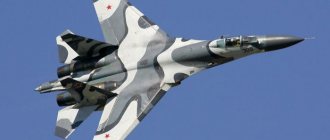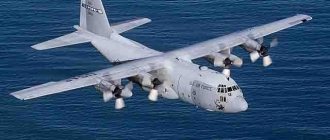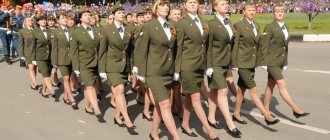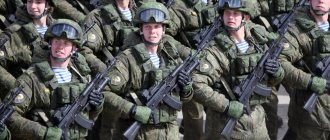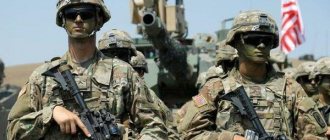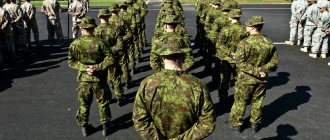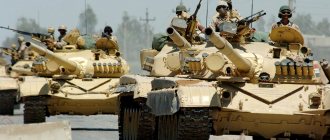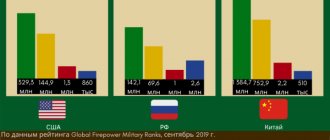From the moment a man picked up a stick, he realized that through violence he could dictate his will. From this time on, the development of military art began. Thus, after a lot of time, the army became one of the main attributes of any state. If we recall the entire human history, then until the 21st century there were constant military conflicts throughout the entire planet. As a result, new territories were conquered, political regimes changed, new religions appeared, etc. In addition, military actions in themselves are quite a profitable business for individuals. However, the destructiveness of wars became clear after World War II. People clearly saw what the frantic progress of military craft, as well as its direct use, could lead to. Fearing for the integrity of the entire planet, the world community decides to change military trends.
Of course, it was not possible to get rid of wars completely. Today, military conflicts still occur in different parts of the Earth, but they are at a purely local level. In addition, the armies of some states began to be created solely for defense, and not for promoting their ideas through war. One of such formations is the army of Saudi Arabia, which will be discussed later in the article.
Saudi Arabia: general information
Before considering the armed forces of Saudi Arabia, it is necessary to generally characterize this state. First of all, it should be noted that the absolute theocratic monarchy in its classical form is still alive in this country. This makes Saudi Arabia quite an interesting “historical monument”. The state is located on the Arabian Peninsula. In fact, it is the largest state in the represented territory. The main religion of Saudi Arabia is Islam. This state is often called the “Land of Two Mosques,” which is not at all surprising, since on the territory of the state there are two main Muslim shrines: Mecca and Medina. It should also be noted that Saudi Arabia is one of the oil exporting countries.
Armed forces of the state
The oil-rich country of Saudi Arabia cannot do without a regular army. Its presence is also due to the relative instability throughout the East. Periodically occurring wars can cause great harm to such a state. The Saudi Arabian army is a combination of several branches of the military, which, in general, corresponds to the classic type of armed forces throughout the world. In addition, the military power of the state has its own history of creation and formation, which will be discussed later in the article.
The UAE begins its journey to the Security Council
There is no doubt that in the future the UN Security Council will repeatedly face discussions of anti-Houthi resolutions, since on January 1, the UAE became a member of this body for a two-year term. In a strange coincidence, this moment coincided with Abu Dhabi's return to the Yemen war and an escalation of the conflict that made the Emirates a new target for the rebels. Previously, this role in the region was assigned only to Saudi Arabia, which regularly reports on the interception of enemy UAVs and missiles.
The Houthis regard the actions of the Arab coalition in the region as an invasion of their state, support for a party that allowed itself to oppress national minorities at the legislative level and thereby provoked a civil war.
Saudi Arabian Armed Forces: history
It should be noted that the army of Saudi Arabia, photos of which are presented in the article, has its own history. However, its time frame is not too long. The thing is that the state itself is relatively young. It, in fact, was formed only in the 20th century, by uniting disparate territorial units. Moreover, the army of Saudi Arabia was formed in the second half of the last century. In addition, the military forces of the United States and Great Britain contributed significantly to the creation of the Saudi Arabian Armed Forces. Today it is known for sure that in the period from 1975 to 1977, there were about 2 thousand military instructors from Britain in the Saudi Arabian forces. There is also another country that took part in creating a strong state in the East. The army of Saudi Arabia, which currently numbers 142 thousand people, owes its weapons to France.
Saudi State Security Service
On July 21, 2022, the royal decree establishing the Office of State Security was made public[]. Departments of the Ministry of Internal Affairs dealing with internal security issues were transferred to the control of the Directorate. As noted in the royal decree, they included the counterintelligence service, special security forces, special emergency forces (used in carrying out special anti-terrorist operations), security aviation, the general maintenance department, the National Counter-Terrorism Information Center - all units related to the fight against terrorism, as well as its financing.
Justifying this step, official propaganda, which accused the Ministry of Internal Affairs of the bureaucratic decision-making process, emphasized that the new Directorate was created to help strengthen national security in the face of the growing influence of extremist ideas and the emergence of new global economic and political threats. The internal political department, which had an extensive infrastructure and significant material and human capabilities, was deprived of powers in the field of border protection, maintaining the security of foreign (in the country) and Saudi (outside) diplomatic missions, as well as protecting critical infrastructure facilities, primarily related to production and oil transportation. The ministry’s educational institution, the Prince Nayef Security Academy, was also transferred to the department. The functions of the internal political department were now concentrated on the fight against criminal offenses and providing services to citizens.
Grigory Kosach: The long-awaited visit of King Salman to Moscow: to new horizons?
Estimates of the number of special forces (as of 2005), previously belonging to the internal political department, are eloquent: border guards - 40 thousand people, special security forces - 10 thousand people, special emergency forces - 30 thousand people, employees various divisions of the general maintenance department - 10 thousand people. In turn, just to protect pilgrims during the Hajj in August 2022, the Ministry of Internal Affairs allocated more than 100 thousand special security troops.
Saudi Special Forces are the equivalent of American Special Weapons Assault Teams (SWAT), equipped with Canadian light armored vehicles, automatic weapons and non-lethal chemical weapons. According to an American expert, the creation of these troops was predetermined by the events associated with the seizure of the Forbidden Mosque in 1979. The activities of the terrorist underground that appealed to religious dogma in the 1990s and early 2000s. stimulated their development and modernization. This equally applied to the special emergency forces, which today have a sufficient number of helicopters to conduct anti-terrorist operations in urban environments. As of the early 2000s, the Saudi National Counter-Terrorism Information Center (with an annual budget of $500 million) had communications and data capabilities, with a computer network connected to 1,100 terminals.
Since 1975, when Mohammed bin Naef's father, Prince Naef bin Abdulaziz, was appointed interior minister, Saudi security has become a monopoly of the dynastic faction he led. The proclamation of Prince Nayef as crown prince in 2009 predetermined the transfer of the post of head of the internal political department to Mohammed bin Nayef, who retained this post after the death of his father in 2011. His position was further strengthened when, at the end of the life of King Abdullah bin Abdulaziz, Mohammed bin Nayef was appointed Deputy Crown Prince, and in January 2015 - Crown Prince and head of the Political and Security Council (overseeing all security ministries and departments).
The current crown prince has concentrated in his hands not only the economic sphere, but also domestic and foreign policy and security.
In the summer of 2022, his nephew, Prince Abdulaziz bin Saud bin Naef, was appointed to replace the removed Interior Minister Mohammed bin Naef. This was only a formal preservation of the internal political department, deprived of most of its structures, under the control of the former dynastic faction. It was not only about the creation of the State Security Directorate, whose head was appointed Lieutenant General Abdel Aziz Al-Huweirni, but also about the destruction of the previous balance of power, since Prince Mohammed bin Nayef was removed from the post of head of the Political and Security Council. The current Crown Prince has concentrated in his hands not only the economic sphere, but also domestic and foreign policy and security, becoming the head of the Council for Political and Security Affairs []. The introduction of the post of head of the State Security Department into the Political and Security Council only proved that the Crown Prince had full control over the capabilities of the newly created structure.
As in the case of the National Guard, the actions of the crown prince were not aimed at destroying the previously created state security institutions. On the contrary, the creation of the Office was explained, among other things, by the fact that this initiative was previously intended to be implemented by Prince Nayef bin Abdulaziz. Abdel Aziz Al-Huweirni is a career officer who served for thirty years in the apparatus of the Ministry of Internal Affairs (where he was one of the closest assistants to Prince Nayef bin Abdul Aziz, who was also responsible for coordinating relations with the United States in the field of anti-terrorism activities) and twice became the target of terrorist attacks. Having become head of the State Security Directorate, Abdel Aziz Al-Huweirni retained his post as head of the counterintelligence department. Having already taken the post of head of the Office, Al-Khuweirni launched an attack on the positions of the religious establishment, authorizing the arrests of several clerics who criticized the government.
Aircraft structure
As stated earlier, the Saudi Arabian army has a classic military force structure. In other words, the troops of this state are based on generally accepted principles. Thus, the structure of the Saudi Arabian Armed Forces includes the following elements:
- ground troops;
— naval forces;
- air Force;
— air defense troops;
— strategic missile forces;
- National Guard.
Each element of the Saudi Arabian army has its own characteristics and specific functions.
Structure [edit]
A Saudi Arabian (HMMWV) with a QCB machine gun mounted on top departs for the seaport of Mogadishu in Somalia.
US Marines train members of the Saudi Arabian Army The Saudi Army's combat force consists of 4 armored, 5 mechanized, 2 light infantry (1 Royal Guard, 1 Special Forces) brigades. The Saudi Arabian Army has deployed the 12th Armored Brigade and the 6th Mechanized Brigade to the King Faisal Cantonment in the Tabuk region. It deployed the 4th Armored Brigade and the 11th Mechanized Brigade to the King Abdulaziz Cantonment in the Khamis Mushait region. He deployed the 20th Mechanized Brigade and the 8th Mechanized Brigade to the King Khalid Cantonment near Hafr al-Batin. The 10th Mechanized Brigade is based in Sharawra, near the Yemeni border and about 150 km from Zamak. [12]
Despite the addition of a number of units and increased mobility achieved during the 1970s and 1980s, the Army's manpower has increased only moderately since the major buildup began in the late 1960s. The Army is chronically understaffed, in the case of some units by an estimated 30 to 50 percent. These shortages were compounded by lenient policies that allowed significant absenteeism and a serious problem with retaining experienced technicians and non-commissioned officers (non-commissioned officers). The continued existence of a separate National Guard also limited the pool of potential military recruits. [12]
Armor
- 4th (King Khaled) Armored Brigade
- 6th (King Fah'd) Armored Brigade
- 7th (Prince Sultan) Armored Brigade
- 8th (King Fah'd) Armored Brigade
- 10th (King Faisal) Armored Brigade
- 12th (Khalid ibn al-Walid) Armored Brigade
A typical Saudi armored brigade has an armored reconnaissance company, three tank battalions of 35 tanks each, a motorized infantry battalion with an armored personnel carrier/armored personnel carrier, and an artillery battalion with 18 self-propelled guns. There is also an Army aviation company, an engineer company, a logistics battalion, a field workshop and a medical company. [13]
Mechanized
- 11th Mechanized Brigade
- 12th Mechanized Brigade
- 13th Mechanized Brigade
- 14th Mechanized Brigade
- 20th Mechanized Brigade
A typical Saudi mechanized brigade has an armored reconnaissance company, one tank battalion with 40 tanks, three motorized infantry battalions with armored personnel carriers/armored personnel carriers, and an artillery battalion with 18 self-propelled guns. There is also an Army aviation company, an engineer company, a logistics battalion, a field workshop and a medical company. It has 24 anti-tank guided weapon launchers and four mortar sections, for a total of eight 81 mm (3 in) mortars. [13]
Infantry
- 16th (King Saud) Light Mechanized Infantry Brigade
- 17th (Abu Bakr Assiddiq) light motorized rifle brigade
- 18th (King Abdullah) Light Motorized Infantry Brigade
- 19th (? Umar ibn al-Khatt? B) light motorized infantry brigade
Each infantry brigade consists of three motorized battalions, an artillery battalion and a support battalion. Army brigades should not be confused with the brigades of the Saudi Arabian National Guard. [ citation needed
]
Airborne forces and special forces
- 1st Airborne Brigade 4th Airborne Battalion
- 5th Airborne Battalion
- 85th Special Forces Battalion
The airborne brigade is usually stationed near Tabuk. The Airborne Forces have two parachute battalions and three special forces companies. Saudi Arabia is expanding its special forces and improving their equipment and training to help deal with the threat of terrorism. The special forces have become independent fighting units that help fight terrorists and report directly to Prince Sultan. [ citation needed
]
Artillery battalions
- five artillery battalions of the 14th FA (towed, 155) battalion
- 15th FA Battalion (MLRS)
- 18th Missile (MLRS) Battalion
Aviation
- 1st Aviation Group
- 2nd Aviation Group
- 3rd Aviation Group
- 4th Aviation Group
A separate regiment of the King's Guard consists of four light infantry battalions. [ citation needed
]
Structure of the Saudi Arabian army (click to enlarge).
Ground forces
The Saudi Arabian army, whose combat effectiveness is largely due to its ground forces and air defense, has about 80 thousand personnel in this sector. In addition, the ground military forces are directly subordinate to the General Staff. The structure of this element of the aircraft is quite surprising. Considering that there are only 80 thousand personnel, this does not prevent the ground forces from including many brigades, namely: armored, mechanized, airborne, eight divisional, as well as troops defending the border. The armament of this component of the army is also at the proper level. The ground forces have 1,055 tanks, 400 mortars, 970 infantry fighting vehicles and about 300 armored vehicles.
Naval forces
The army in Saudi Arabia also has a navy in its structure. The tasks of this sector of the armed forces include the protection of territorial waters, coasts, sea shelves, oil infrastructure facilities, etc. Many scientists do not understand why this state needs a Navy. The fact is that the country is washed on both sides by water. To the west is the Red Sea, and to the northeast is the Persian Gulf. Thus, if desired, it is quite possible to attack the state from water. It should be noted that the main reason why the navy was created was the seizure of some islands belonging to Saudi Arabia by the Shah of Iran. The United States of America began modernizing the Navy, in accordance with the agreement signed between the countries. Already in 1991, this element of the armed forces consisted of 9.5 thousand people.
Today, the number of Saudi Arabian naval forces is about 15.5 thousand people. This also includes 3 thousand Marines. Military-technical cooperation has still not lost its popularity for Saudi Arabia. Today, the state actively maintains relations with Great Britain, Italy, France, and the United States.
Country's air force
It should be noted that Saudi Arabia currently has the second largest aircraft fleet after Israel. The strongest army, of course, is not in this state, but in terms of aviation the country does not lag behind, but, on the contrary, surpasses many. Firstly, it is necessary to note the technical potential of the country. The fleet is represented by A-15 aircraft, effective for performing combat missions. Secondly, the size of the air force is 20,000 people. In addition, Saudi Arabia proved its combat capability in the field of air defense in 1984, when a conflict occurred with Iran. In addition, the state air force performed excellently in the operation directed against Iraq, which was called “Desert Storm”.
It should be noted that the state leadership actively controls the process of replenishing the armed forces with new personnel, especially when it comes to the air force. This is evidenced by the fact that in Saudi Arabia there is a special Aviation Academy named after King Faisal. It is located at the air base in Al Kharj. Airfields are located throughout the entire state, especially near borders with other countries. This allows you to effectively defend yourself in the event of an unexpected invasion.
Why the bloated defense budget failed to help the Saudi army become effective
The blow to the Saudi oil industry, inflicted on the night of September 14, either by Iran or by Yemeni groups oriented towards it, was truly devastating. Its consequences will be much more significant than short-term interruptions in the kingdom’s oil production and fluctuations in the price of black gold.
This attack clearly showed that about a dozen primitive subsonic cruise missiles and a couple dozen less advanced drones are enough to threaten the largest oil industry in the world.
An incredibly bloated defense budget did not protect Saudi Arabia from attacks by primitive missiles and drones from impoverished Yemen. Pictured: Satellite imagery of damage to Saudi oil fields
HO / PLANET LABS INC. /AFP/East Nees
The fact that $67.6 billion a year is spent on protecting this oil (estimate of the Saudi military budget in 2018) does not change anything.
“I think the Saudi leadership must explain how a country that has the third largest military expenditure in the world [...] could not protect its most critical oil facility from such attacks,” the ex -US Ambassador to Oman Gary Grappo.
But here we should ask the question: why did we even decide that military power can be proportional to military spending and, even more so, to the size of GDP? The last argument, for all its ludicrousness, periodically emerges at a fairly high level.
For example, Donald Trump's recently fired national security adviser John Bolton once said that "even though the Russian economy is about the size of the Netherlands (which, by the way, is not true - Profile), it still spends enough money to modernize its nuclear arsenal."
The problem of the correlation between GDP and the military capabilities of the state is solved simply - these two parameters are not directly related. And this has been proven more than once by history.
The largest economy in the first half of the 19th century was the Qing Empire. However, this did not stop the Europeans, and then the Japanese, from turning it into an object of endless plunder.
Attempts to explain this situation by technological backwardness are untenable. As part of the “policy of self-strengthening,” China, starting in the 1860s, built a number of industrial enterprises that produced weapons that were quite advanced for that time. Even more of it was purchased abroad.
This did not bring success to the Chinese. In the catastrophic battle for them at the mouth of the Yalu River on September 17, 1894, the Chinese had two brand new German battleships and ten cruisers against the eight cruisers of the Japanese. The Chinese were better armed, but their fleet was defeated.
China attracted many European military advisers and adopted Western tactical innovations. It was all futile simply because of the mismatch between China's social structure and the Western military organization it was trying to adopt. The attempt to place the subjects of the traditional Confucian empire into mechanically borrowed Western organizational forms was doomed to failure. The various components of this machine in such a situation did not interact as intended by the design; the tools of motivation, maintaining discipline, and decision-making procedures embedded in it did not work.
It is easy to see parallels here with Saudi Arabia - a country where an extremely archaic structure of society with a mass of feudal and tribal remnants, a persistent class stratification is combined with attempts to build a modern military machine, spending huge amounts of money on it. The need to ensure the political loyalty of the army to the archaic ruling regime and respect for the interests of all influence groups involved in the political process is incompatible with attempts to build a military organization on a Western model.
How this works can be seen in the Saudi Arabia section of a 2008 American military handbook. First of all, it notes the low attractiveness of a military career compared to the civil service, which is full of sinecures. As a result, the motivation of military personnel is extremely low; they are virtually unable to perform technically complex tasks that require literacy and attention.
The kingdom's officer corps did not become a professional corporation with its own traditions and values - the work on its formation was sacrificed for the sake of employment and maintaining the status of numerous descendants of the ruling house. The organizational structure and management system of the army are specially fragmented to prevent the military from acting against the ruling regime; the consequence of this is a very low level of interaction between military branches and branches of the armed forces and poor planning.
Problems arise primarily with the provision of qualified junior technical specialists necessary for a modern army. These people must not only be literate, but also have a certain level of general culture in order to comply with complex regulations and procedures for caring for military equipment even when they are not directly controlled by management.
And in Saudi Arabia, when forming the command staff, what is primarily taken into account is not the knowledge and real merits of the officers, but their origin. Primitive institutions and undeveloped political identity require primitive tools to ensure the loyalty of the army, which, in turn, leads to the suppression of the initiative of commanders.
Combined with the low level of basic school education in the country, it becomes impossible to organize the planning of complex operations and especially the organization of logistics support.
Chronic problems with supply, technical support and manning are characteristic of all cases where socially underdeveloped countries have tried to build effective military organizations by inflating defense budgets.
The factors that made it impossible to build a modern army in Saudi Arabia were obvious to the first American military advisers who visited the country in the 1950s. They noted the complete illiteracy of the population; problems with obedience and understanding instructions due to medieval ideas about honor; impossibility of training high-quality technical personnel in sufficient quantities.
The size of the defense budget in this case should be assessed taking into account a lot of adjustments downward to its real value. To a large extent, they are due to the lack of a defense industry in the country. And Saudi Arabia in military-industrial terms is lower than Qing China in the last decades of its existence.
Imperial China during the time of Empress Cixi was able to produce independently and in significant quantities decent examples of small arms and artillery systems, as well as build small warships. The production of this equipment and its maintenance in the troops was carried out by local personnel.
A representative of the Kingdom's Ministry of Defense shows the wreckage of Houthi drones and missiles
EPA/TASS
Now, in the 21st century, the defense industry of Saudi Arabia is only capable of assembling certain types of foreign military equipment from imported vehicle kits (for example, Chinese Yilun-2 drones). The Saudis can also produce simple light armored vehicles based on foreign vehicles (for example, Al Shibl‑1 and -2 light vehicles based on the Toyota Land Cruiser and Tuwaiq mine-protected vehicles based on the Mercedes-Benz UNIMOG U‑5000). In general, of the total procurement expenditures of the kingdom's armed forces on weapons, only 2% goes to national manufacturers.
All weapons are purchased by Riyadh abroad at inflated prices and, judging by all available data, with a very significant corruption margin.
Added to this is the inability of the Saudi military to independently maintain this equipment. For this reason, thousands of specialists from weapons manufacturing enterprises are constantly in the kingdom. Their work is paid at the highest level, since without them the equipment will not work. Foreign specialists are present not only at repair facilities in the rear, but also at forward bases. They are permanently located in Saudi military units, providing training and maintenance of weapons systems - the number of British contractors alone engaged in such work reaches 6,300.
For comparison: Saudi Arabia's main enemy, Iran, with a military budget more than three times smaller, managed to create a powerful defense industry that provides the basic needs of the armed forces. Iran, on its own or with limited foreign assistance, produces a full range of air defense systems, including the Bavar-373 long-range system (Iranian S-300), early warning radars, ballistic and cruise missiles, numerous types of small arms and light weapons, light submarines, combat boats and much more.
The very high level of technical culture in the Iranian armed forces is evidenced by the fact that the country continues to use numerous examples of complex military equipment purchased from the United States by the Shah's regime more than 40 years ago. Their maintenance is carried out in complete absence of contact with the manufacturer.
As a result, while the Saudi military budget is actually significantly smaller than it appears at first glance, Iran's real military budget is significantly higher than its nominal values. Total Iranian military spending for the 2018/19 fiscal year was estimated by IISS at $19.6 billion at current exchange rates. However, the undervaluation of the rial in relation to the dollar (the exchange rate at purchasing power parity is approximately three times lower than the current one) and the fact that most of the equipment is produced within the country and all of it is serviced in-house, radically changes the situation.
Finally, the Iranian armed forces can rely on the powerful education system created in the country (Iran, by the way, is among the leaders in the growth rate of scientific publications in international journals), which provides educated and motivated personnel.
It is known that the Iranian army and the Islamic Revolutionary Guard Corps, preparing for a war with a technically superior enemy capable of disabling communication and control systems in the first hours of the conflict, rely on encouraging the initiative of their officers, who are specially trained to act independently in conditions of lack of information.
Saudi Arabia is a typical example of how misleading and harmful attempts to assess the military and, as a consequence, political significance of a state based on macroeconomic indicators can be. Such attempts should be avoided in principle, since the relationship between economic and even industrial power and military capabilities is nonlinear and greatly changes its character as science and technology develop.
Strategic Missile Forces
The most powerful missile forces in Saudi Arabia are the missile forces. Their combat effectiveness is determined by some basic factors. First of all, it should be noted that this Saudi Arabian military group is armed with DF-3 ballistic missiles. In addition, in 2014, a rumor leaked to the press that the state had acquired a new type of ballistic missile, the DF-21 type, from the People's Republic of China. US authorities, represented by the Central Intelligence Agency, confirmed this rumor, indicating that the deal was carried out in 2007. There are also about 5 missile bases throughout Saudi Arabia. The headquarters of this element of the armed forces is in Riyadh. In 2013, the missile forces command was located in a new luxurious building, which was opened in parallel with the Academy of Strategic Missile Forces.
Royal Saudi Air Defense Forces
Number : up to 16 thousand people
It is the Royal Saudi Air Defense Forces that are entrusted with the task of covering important administrative, military and economic bases and facilities: the country's capital, troop groups, naval, air and missile bases, and oil production areas.
The main command post of the country's air defense system, which is integrated into the Peace Shield system, is located in an underground complex in Riyadh. Air defense forces are represented by anti-aircraft missile systems, anti-aircraft artillery, and units of radio technical troops. Air Force fighters are operationally subordinate to the air defense forces.
Armament
Organizationally, the country's air defense forces are consolidated into 6 groups (districts). The backbone of the air defense system consists of 17 AN/FPS-117(V)3 long-range radars, which are coupled with a large number of tactical radars. Air defense systems are interconnected using the Peace Shield command, control, reconnaissance and communications system. The country's air defense includes up to 12 batteries of towed Patriot PAC-2 air defense systems (96 launchers), with plans to upgrade to the PAC-3 level, and 16 batteries of modernized I-Hawk air defense systems (128 launchers). There are also about 600 short-range air defense systems (400 American Avenger, 40 French Crotal and 141 Shaheen). About 1,000 units of 20–40 mm anti-aircraft artillery systems are in service.
Rumors about nuclear weapons
Today there are many rumors in the world about the existence of nuclear weapons in Saudi Arabia. There is no confirmation of this information, as well as information about the exact number of strategic missile forces, which raises a lot of questions. Thus, it cannot be said that the Saudi Arabian army is weak, because there is simply no accurate information about it. However, according to statements by the ruling elite, namely King Abdullah and Prince Turki ibn Faisal Al Saud, the state is striving with all its might to acquire nuclear weapons, which will become a countermeasure against the nuclear program of the state of Iran.
There are also many rumors that Saudi Arabia and Pakistan have allegedly entered into a secret agreement, according to which the latter party can provide weapons to the state mentioned in the article in the event of a military crisis in the East.

